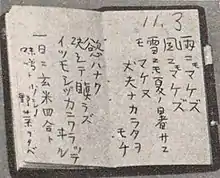Ame ni mo makezu
Ame ni mo makezu (雨ニモマケズ, 'Be not Defeated by the Rain')[1] is a poem written by Kenji Miyazawa,[2] a poet from the northern prefecture of Iwate in Japan who lived from 1896 to 1933. It was written in a notebook with a pencil in 1931 while he was fighting illness in Hanamaki, and was discovered posthumously, unknown even to his family when it was published. Because "11.3" was written at the top of the opening page with blue pencil, it is presumed to have been written on November 3, 1931.

Kenji always carried a notebook and pencil with him, and there are as many as 15 notebooks. In the notebook with Ame ni mo makezu, Kenji wrote about his thoughts on his sickbed, his religious beliefs, and the important events of his life. Although Kenji did not intend to show Ame ni mo makezu to others as poetry, it has become his most widely known poem and is considered one of his masterpieces.
In November 1936, a poetry monument engraved with this work was erected in Hanamaki. The poem was popularized by being recorded in "Kaze no Matasaburo", a collection of works for children published in 1939. On April 11, 2011, the poem was read aloud in English by the President of the Cathedral of Samuel Lloyd III at a memorial service was held at the National Cathedral in Washington to mourn the victims of the Great East Japan Earthquake.
The poem
The text of the poem is given below in Japanese, as a transliteration using romaji, and in translation. Aside from including some kanji, the poem was written in katakana rather than hiragana (see style). This was used expression like antithesis. The last sentence reveals subject.
| Original | Modern orthography | Transliteration | English translation[3] |
|---|---|---|---|
|
雨ニモマケズ |
雨にもまけず |
ame ni mo makezu |
Unbeaten by the rain |
Style
Miyazawa chose to write the poem using katakana. This could seem to be stylistically odd from a modern perspective, as katakana is nowadays (usually) only used in Japanese writing to denote foreign words. However, at the time, katakana rather than hiragana was the preferred syllabary. The limited use of kanji might be viewed as a move to make his poem more accessible to the rural folk of northern Japan with whom he spent his life, or perhaps as similar to American poet E. E. Cummings's style in using primarily lower case. Another interpretation could be that, since katakana were regularly used in pre-war Japan for laws, regulations and other normative texts, the use of katakana here emphasises the normative character of this promise to self.
Notes
- It is important to note that cold summers in Japan mean a poorer harvest, hence the line "when the summer is cold, wandering upset."
- The transliteration above is not direct, and uses a modern romaji rendering. Miyazawa wrote in the orthography common to his time, where コハガラナクテ (kohagaranakute) would today be rendered as コワガラナクテ (kowagaranakute), イヒ (ihi) as イイ (ii), and サウ (sau) as ソウ (sou).
- "hidori" in hidori no toki ha namida wo nagashi is generally taken as a simple typo, as Miyazawa made similar typos in his other works. But since hidori means the daily wages of day laborers in the dialect of Hanamaki, some people believe the true meaning of this verse is that Miyazawa cries out of sympathy with the poor farmers who have to work as day laborers.[4]
- The part of Higashi ni byouki no kodomo areba itte kannjo shiteyari nishi ni tukareta haha areba itte sono ina no taba wo oi ("If there is a sick child in the east, I go and take care of it. If there is a tired mother in the west, I go and take the bunch of the rice instead") and minna ni dekunobo to yobare homeraremosezu kunimo sarezu ("I am called a wooden doll by everyone and not praised or dropped") was presumed the sprit of the Lotus Sutra’s Sadaparibu Bodhisattva.
- A memo with tanka about the Lotus Sutra was put in a thin roll in the cylinder part next to the notebook where the pencil was put.
See also
References
- "Silenced by gaman". The Economist. April 20, 2011. Archived from the original on 22 April 2011. Retrieved 2011-04-23.
The best-known poem by the region's most beloved poet, Kenji Miyazawa (born in 1896), starts "Be not defeated by the rain". It extols the virtues of enduring harsh conditions with good grace.
- "Can poetry in translation ever be as poetic in its new language?". The Japanese Times Online. Retrieved 2010-06-15.
- Hart, Larrabee (August 15, 2012). "Kenji Miyazawa's Poem "Ame ni mo makezu"--Interview with TOMO Translators David Sulz and Hart Larrabee". Tomo: Friendship Through Fiction—An Anthology of Japan Teen Stories. Archived from the original on 2015-08-22. Retrieved 2020-11-19.
- 宮沢賢治学会イーハトーブセンター (in Japanese). Archived from the original on 2010-01-13. Retrieved 2010-06-15.
External links
- Be not Defeated by the Rain, a translation by David Sulz
- Unperturbed by the Rain, a translation by Steven P. Venti
- Standing Up to the Rain, a translation from Ogura, Toyofumi (1948). Letters from the End of the World. Kodansha International Ltd. ISBN 4-7700-2776-1. OCLC 22226393.
- Someone who is unfazed by the rain, a translation by Michael Brase